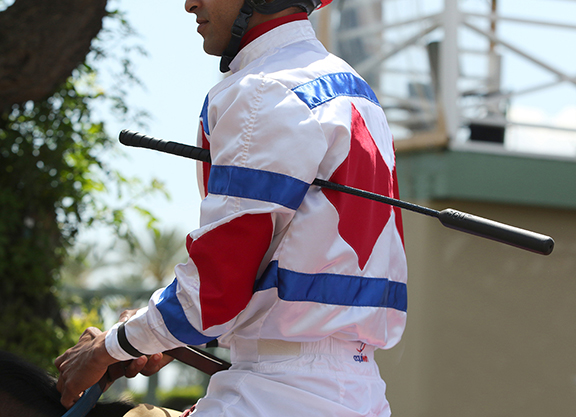By T. D. Thornton
After initially being deadlocked on a Thursday vote to put off implementing anti-whipping regulations that have been repeatedly delayed since first proposed in March 2019, the California Horse Racing Board (CHRB) finally voted 4-2 to pass a rule that will prohibit a jockey from striking a mount more than six times during a race, and then only in an underhanded position with no more than two strikes in succession using whips that must meet new CHRB standards to soften the blows.
Representatives from the Jockeys' Guild, plus California riders Mike Smith and Aaron Gryder, repeatedly advocated for the board to wait at least one more month before voting on the rule to allow more time for a proposed national whip standards rule to come to fruition.
But in a contentious meeting that stretched nearly seven hours, CHRB chairman Gregory Ferraro, DVM, spearheaded the push to once and for all settle the whip rule based on the rationale that he believes no such national standard is actually forthcoming, and that California should be a leader and not a follower when it comes to reforming how racehorses are treated.
“I don't believe you're going to see a national rule,” Ferraro said. “I would like a national rule, but I don't think it's going to happen. It's definitely not going to happen with any speed at all. It could be years. This board has a mandate from the governor to make reforms in racing that contribute to the welfare of the horse. We've been talking about this crop rule for two years. I think it's time to stop procrastinating and pass a rule. We have a good rule. We worked hard on it.
“If we're going to have some leadership in California, we need to pass this rule and let the rest of the nation follow our lead,” Ferraro said prior to the vote. “We're never going to please the jocks. They don't want to do anything but keep the status quo. We appreciate their argument. But it's not going to fly in the face of the public demand that we quit hitting these horses.”
Shane Gusman, an attorney representing the Jockeys' Guild, testified prior to the vote that whipping guidelines based on public perception would lead to on-track catastrophes and would doom the sport in California.
“We're concerned that it's not going to work, and that there's going to be real safety issues when a jockey is unable to perform his or her job,” Gusman said. “What will happen is you're going to get an accident, and either a jockey is going to get hurt or a horse is going to go down. And that is not what your intent is here. I know that. But we're concerned that the way this rule is crafted, that's what's going to happen.
“[The rule] is not based on what's best for the situation. It's based on perception,” Gusman said. “You're going to end racing in California. It's just going to happen if you go down this road of trying to regulate perception rather than reality.”
In addition to the above-mentioned restrictions, the newly amended version of CHRB Rule 1688 will also prohibit the use of the riding crop during morning training and after the finish of races.
According to the CHRB meeting information packet, the correct uses of the riding crop will now include “showing or waving the crop without touching the horse…and tapping the horse on the shoulder with the crop in the down position.”
The new rule will also establish “a maximum fine of $1,000 and minimum suspension of three days for riding in a manner contrary to the rule.”
There will be no penalty if the stewards determine that the use of the riding crop was “necessary for the safety of the horse or rider.”
Terence Meyocks, the president and chief executive officer of the Jockeys' Guild, noted that work is progressing in other jurisdictions, particularly among a coalition of mid-Atlantic region tracks, to come up with a standardized version of whipping rules that have been crafted with the input of riders in mind. He explained that he would like to see California on board with any proposed rule that might result from those multi-party discussions in the next few weeks.
“The Jockeys' Guild and riders today need a national rule,” Meyocks said. “I think we're so much closer to a national rule in the United States, and I think that this is our best chance…. It's the Guild's request at this time to ask for an extension of no more than four to six weeks to see if we can reach an agreement on the riding crop in the United States.”
But Scott Chaney, the CHRB's new executive director, told commissioners before the vote that he didn't buy that line of reasoning.
“This idea about a national standard is not a 'thing.' It just doesn't exist,” Chaney said. “I guess maybe we're talking about some agreement between the Jockeys' Guild and the safety coalition. But that's not a national standard. That's just an idea that a sub-group of the country has. It would require every other state to pass a rule, which just is not going to happen.”
Prior to passing the new rule, the CHRB first voted unanimously to codify the standards that mandate a more humanely constructed riding crop.
Initially, the standards were designed to incorporate the specifications for the 360 Gentle Touch riding crop, which is the design manufactured by retired Hall-of-Fame jockey Ramon Dominguez. But the version passed on Thursday was rewritten to just outline the specifics of the whip a jockey can carry. It does not mandate that riders use a whip made by any specific manufacturer.
After passing that measure, the CHRB took up the in-race whipping rule itself, which turned out to be much more complicated.
After hearing lengthy and often repetitive testimony from the jockeys and the Guild about the need to wait a bit more, several commissioners seemed inclined to do just that.
Commissioner Alex Solis, a retired Hall-of-Fame jockey, made the motion to table voting on the new anti-whipping rule until the July CHRB meeting. But the six commissioners deadlocked on this motion, with commissioners Solis, Dennis Alfieri, and Oscar Gonzales voting to wait another month, while commissioners Ferraro, Wendy Mitchell, and Damascus Castellanos voted not to table the agenda item.
Ferraro then wanted to move the question to approve the anti-whipping measure as written. But the board had to pause the meeting to research state law, because nobody on the conference call immediately knew if another tie would mean the long-debated rule would be dead on the spot, or if it could be resurrected again at some point in the future.
After a delay while the CHRB addressed another agenda item, legal staffers came back with the verdict that if the board deadlocked on passing the whip reform rules they had worked on since early 2019, the motion would be dead.
With the gravity of that potential outcome in mind, the question was moved to approve the anti-whipping rule. It passed, 4-2, with Solis and Alfieri holding out as the “no” votes.
Now that the new whipping rules have been passed, the CHRB must submit the proper paperwork to the state Office of Administrative Law, which will review the technical details, possibly in time for an effective date of Oct. 1.
Not a subscriber? Click here to sign up for the daily PDF or alerts.






